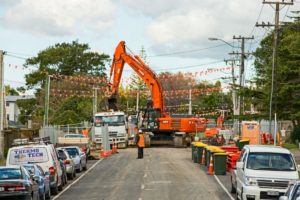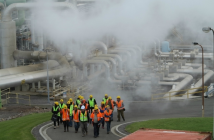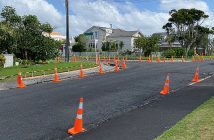 A zero-harm approach on a key infrastructure project led the Fulton Hogan John Holland Joint Venture to success at the 2016 Site Safe Health and Safety in Construction Awards
A zero-harm approach on a key infrastructure project led the Fulton Hogan John Holland Joint Venture to success at the 2016 Site Safe Health and Safety in Construction Awards
A major project to protect the security of Auckland’s water supply, the Hunua 4 watermain runs for 31km, from Redoubt North Reservoir in Manukau Heights to the Khyber Pass Reservoir.
The Fulton Hogan John Holland Joint Venture was awarded the contract for sections 1 to 10 of the project, and the team were determined to lead the industry by making the project the new health and safety benchmark for major water infrastructure projects.
At its peak, the Fulton Hogan John Holland Joint Venture had as many as 120 workers on-site, often in residential streets and near to large plant and services such as overhead powerlines.
With the excavation plant weighing as much as 47 tonnes, the risk of striking nearby workers, services, trees, or other roadside structures was high.
Such a strike could cause a serious injury or fatality, as well as service disruptions for thousands of customers, but due to the need to maintain services to vital places such as hospitals, businesses and schools, it was usually not practicable to arrange shutdowns or outages. Deep trenches also presented a significant work at height and confined space risk.
From the outset, the team knew they wanted to push the boundaries of health and safety practice and set a new standard with a Zero Harm approach.
The first step was selecting main subcontractors, March Cato and Taranaki Engineering, who were open to new ideas and better ways of doing things.
Then, over the span of the four and a half-year project, the team designed and implemented a range of wide-reaching initiatives to address the risks and issues they identified.
One of the key risks they quickly identified was hitting services, such as overhead powerlines, as well as other workers near the heavy plant.
The team recognised the need for a constant second pair of eyes to see what plant operators could not.
The introduction of mandatory named and dedicated spotters led to what Project Manager Tony Mills says was one of their standout safety initiatives, the Spotter Competency Programme and Handbook.
“The New Zealand culture on-site is that everyone on site is supposed to be the spotter. But when we looked at it, we saw that this usually meant nobody was actually spotting.
“Even when a dedicated spotter had been assigned, they usually hadn’t received any training and were often the least suitable person for the job, so it was clear that we needed a step change.”
One way the team addressed the issue was by improving the communication between spotters and operators.
Spotters and operators were taken to a flight simulator which they operated in pairs to fly the plane to a set route, and also completed an obstacle course where one was blindfolded and guided through the course by directions from their partner with the aim of improving positive communication.
These programmes sparked the development of a standardised framework for assessing spotter competency, and a set of standardised hand signals for spotting.
The programme was so successful that following its introduction there were no strikes with known services.
Another key programme introduced on the project was the “Just Culture Committee”, which was set up to review the consequences of not following the agreed “Golden” rules.
Mills says the inclusion of representatives from all the major contractors helped foster a crucial sense of trust amongst those on-site.
“People knew that their case would be heard by the whole group and that whatever happened, it would be a fair, majority decision.
“Developing that sense of trust helped everyone to have sensible conversations, and not be afraid to speak up.”
Some of the other key programmes implemented during the project included:
Confined Space Handbook – this was created to supplement existing training and was specifically tailored to the water sector
Trench Handrail System – subcontractor March Cato and the project team developed a bespoke handrail system for trenches which can be deployed in any trench regardless of the shoring system
Supervisor Training Programme – a unique, site-based leadership development programme aimed at upskilling frontline supervisors and foremen
Overhead Services Flagging – a project-designed system of flags installed just below overhead powerlines to create a buffer zone between plant and the lines which, combined with the spotter programme, helped to eliminate overhead power strikes once it was deployed
Start Cards – an individual daily risk assessment designed to lift workers’ awareness of their working environment
The Golden Rules – the project established a clear set of safety rules and behaviours, along with a “yellow” and “red” card system for breaches
Positive Performance Scorecards – instead of just recording lag incidents, the Safety Scorecards measured key areas such as management commitment, training and competency, and risk management on a monthly basis. Crews who exceeded the benchmark were rewarded with a full team breakfast at the monthly Toolbox Talk and entered into the “Crew of the Month” competition.
Working smarter
Good health and safety systems are simply part of a well-planned approach, which means a better, faster, more profitable job, Mills believes.
“Essentially it all comes down to proper planning – if you have properly planned your works, you can predict the potentially unexpected circumstances and implement mitigation strategies to prevent them occurring in the first instance, so in the end you are more productive, efficient and profitable.”
He says their focus on a Zero Harm culture has set a new benchmark in the water industry, with elements of their health and safety programme, such as the handrail system and handbooks, being adopted by Watercare, Auckland’s main water provider.
These achievements are clearly having an impact across the water industry, with many other companies looking to follow their lead.
“We firmly believe in the mantra of what goes around comes around, and by giving to the industry we all collectively benefit.”
And it’s an approach that has delivered proven results, with the project at one point running for 14 months without any recordable incidents on-site.
By the end of the four and a half-year project, 1.4 million man hours had been worked without recording any Lost Time Injuries.
But at the end of the day, seeing workers home safe was the most important measure of their success, Mills insists.
“We didn’t want to see anyone hurt – from the very beginning that has always been the main driver.
“So in that sense, what we accomplished was a huge achievement.”




